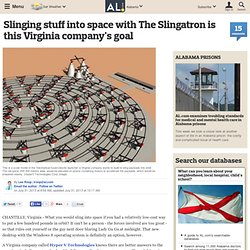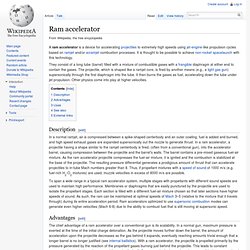

Space Elevators Are Totally Possible (and Will Make Rockets Seem Dumb) It's the scourge of futurists everywhere: The space elevator can't seem to shake its image as something that's just ridiculous, laughed off as the stuff of sci-fi novels and overactive imaginations.

But there are plenty of scientists who take the idea quite seriously, and they’re trying to buck that perception. Non-rocket spacelaunch. Present-day launch costs are very high – $2,500 to $15,000 per kilogram from Earth to low Earth orbit (LEO).

As a result, launch costs are a large percentage of the cost of all space endeavors. If launch can be made cheaper the total cost of space missions will be reduced. Fortunately, due to the exponential nature of the rocket equation, providing even a small amount of the velocity to LEO by other means has the potential of greatly reducing the cost of getting to orbit. Launch costs in the hundreds of dollars per kilogram would make possible many proposed large-scale space projects such as space colonization, space-based solar power[3] and terraforming Mars.[4]
Slinging stuff into space with The Slingatron is this Virginia company's goal. This is a scale model of the 'mechanical hypervelocity launcher' a Virginia company wants to build to sling payloads into orbit.

The rail spiral, 200-300 meters wide, would be elevated on pylons containing motors to accelerate the payloads, which would be prepared nearby. (HyperV Technologies Corp. image) Ram accelerator. A ram accelerator is a device for accelerating projectiles to extremely high speeds using jet-engine-like propulsion cycles based on ramjet and/or scramjet combustion processes.

It is thought to be possible to achieve non-rocket spacelaunch with this technology. They consist of a long tube (barrel) filled with a mixture of combustible gases with a frangible diaphragm at either end to contain the gases. The projectile, which is shaped like a ramjet core, is fired by another means (e.g., a light gas gun) supersonically through the first diaphragm into the tube. It then burns the gases as fuel, accelerating down the tube under jet propulsion. Other physics come into play at higher velocities. Description[edit] In a normal ramjet, air is compressed between a spike-shaped centerbody and an outer cowling, fuel is added and burned, and high speed exhaust gases are expanded supersonically out the nozzle to generate thrust. Spaceplane. A Space Shuttle rocketing into space, just after booster separation.

Description[edit] Significant features distinguish spaceplanes from spacecraft. Aerodynamic lift[edit] Atmospheric reentry[edit] Because suborbital spaceplanes are designed for trajectories that do not reach orbital speed, they do not need the kinds of thermal protection orbital spacecraft required during the hypersonic phase of atmospheric reentry. Aircraft landing[edit] Propulsion[edit] Buran orbiter rear showing rocket engine nozzles, for maneuvering in low Earth orbit and thin air Rocket engines[edit] All spaceplanes to date have used rocket engines with chemical fuels.
Japanese Company To Build an Elevator From Earth to Space. Imagine stepping into an elevator, pressing the “Space” button and sometime later, floating in space!!.

How cool will that be? This might sound madness now but glad fully, one Japanese company is ready to put money on this idea. This capability of providing a direct lift to space will open new avenues of research for scientists, NASA projects or even entertainment for public! StarTram. Hypothetical StarTram spaceport.

The launch tube stretches into the distance to the East on the right (eventually curving up many kilometers away), next to the power plant which charges the SMES. RLVs return to land on the runway. History[edit] A track on test model scale for lower velocity magnetic launch assist. A prior concept for likewise a maglev horizontal launch assist system but at far lesser velocity: MagLifter. A StarTram design was first published in a 2001 paper[3] and patent,[4] making reference to a 1994 paper on MagLifter. Subsequent design modifies StarTram into a generation 1 version, a generation 2 version, and an alternative generation 1.5 variant.[1] Laser propulsion. Laser propulsion is a form of beam-powered propulsion where the energy source is a remote (usually ground-based) laser system and separate from the reaction mass.

This form of propulsion differs from a conventional chemical rocket where both energy and reaction mass come from the solid or liquid propellants carried on board the vehicle. A laser launch Heat Exchanger Thruster system History[edit] The basic concepts underlying laser propulsion were first developed by Eugene Sanger and the Hungarian physicist Georgii Marx, with practical schemes being developed by Arthur Kantrowitz and Wolfgang Moekel in the 1970s.[1] Laser propulsion systems may transfer momentum to a spacecraft in two different ways. The forms described below are all of the second type, and could be described as thermal rockets. The Nuclear Potato Cannon Part 2. As described in an earlier post (see above) in 1957, the Soviet scientists launched Sputnik from the Baikonur Cosmodrome in what is now Kazakhstan.

But was it the first man made object shot into space? Maybe, maybe not. The nuclear test code named Bernalillo had a nuclear device which was relatively puny, having explosive equivalent of less than a kiloton of high explosive. But, small in nuclear terms is still very large and loosing large amounts of energy has hard-to-predict effects. Dr.